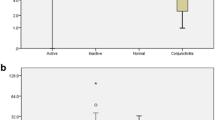Abstract
Purpose
To measure tear nerve growth factor (NGF) concentrations in cases of active thyroid-associated ophthalmopathy (TAO) before and after glucocorticoid treatment, and to correlate NGF levels with disease inflammatory activity and thyroid autoantibody concentration.
Methods
The study involved 20 patients with active TAO and 20 age- and gender-matched controls. Tear break-up time (BUT) was obtained, the Schirmer test was performed, and tear NGF/total protein ratio was measured in control subjects and patients with active TAO before, and 2 and 4 weeks after, steroid treatment.
Results
Tear BUT and Schirmer values significantly increased after 2 and 4 weeks of steroid treatment (p < 0.001 and p = 0.004 respectively). Baseline tear NGF/total protein ratio was higher in patients with active TAO than in control subjects, and the ratio significantly decreased after 2 and 4 weeks of steroid treatment (p < 0.001). Tear NGF/total protein ratio did not correlate with inflammatory activity score, exophthalmos value and thyroid binding inhibiting immunoglobulin (TBII) level (p > 0.05).
Conclusions
Tear NGF may have a specific role in ocular surface inflammation, which protects against ocular surface damage in patients with active TAO. Anti-inflammatory treatment significantly reduced the level of NGF in tears, increased tear film stability and production, and decreased congestive symptoms.

Similar content being viewed by others
References
Gilbard JP, Farris RL (1983) Ocular surface drying and tear film osmolarity in thyroid eye disease. Acta Ophthalmol (Copenh) 61:108–116
Khurana AK, Sunder S, Ahluwalia BK, Malhotra KC (1992) Tear film profile in Graves’ ophthalmopathy. Acta Ophthalmol (Copenh) 70:346–349
Trokel SL, Jakobiec FA (1981) Correlation of CT scanning and pathologic features of ophthalmic Graves’ disease. Ophthalmology 88:553–564
Chang TC, Huang KM, Chang TJ, Lin SL (1990) Correlation of orbital computed tomography and antibodies in patients with hyperthyroid Graves’ disease. Clin Endocrinol (Oxf) 32:551–558
Jacobson DH, Gorman CA (1984) Endocrine ophthalmopathy: current ideas concerning etiology, pathogenesis, and treatment. Endocr Rev 5:200–220
Moncayo R, Baldissera I, Decristoforo C, Kendler D, Donnemiller E (1997) Evaluation of immunological mechanisms mediating thyroid-associated ophthalmopathy by radionuclide imaging using the somatostatin analog 111In-octreotide. Thyroid 7:21–29
Khalil HA, de Keizer RJ, Kijlstra A (1988) Analysis of tear proteins in Graves’ ophthalmopathy by high performance liquid chromatography. Am J Ophthalmol 106:186–190
Eckstein AK, Finkenrath A, Heiligenhaus A, Renzing-Kohler K, Esser J, Kruger C, Quadbeck B, Steuhl KP, Gieseler RK (2004) Dry eye syndrome in thyroid-associated ophthalmopathy: lacrimal expression of TSH receptor suggests involvement of TSHR-specific autoantibodies. Acta Ophthalmol Scand 82:291–297
Crisp MS, Lane C, Halliwell M, Wynford-Thomas D, Ludgate M (1997) Thyrotropin receptor transcripts in human adipose tissue. J Clin Endocrinol Metab 82:2003–2005
Levi-Montalcini R, Aloe L, Alleva E (1990) A role of nerve growth factor in nervous, endocrine, and immune system. Prog Neuro Endocrin Immunol 3:1–10
Lambiase A, Manni L, Bonini S, Rama P, Micera A, Aloe L (2000) Nerve growth factor promotes corneal healing: structural, biochemical, and molecular analyses of rat and human corneas. Invest Ophthalmol Vis Sci 41:1063–1069
Levi-Schaffer F, Micera A, Zamir E, Mechoulam H, Puxeddu I, Piliponsky AM, Aloe L, Pe’er J (2002) Nerve growth factor and eosinophils in inflamed juvenile conjunctival nevus. Invest Ophthalmol Vis Sci 43:1850–1856
Nguyen DH, Beuerman RW, Thompson HW, DiLoreto DA (1997) Growth factor and neurotrophic factor mRNA in human lacrimal gland. Cornea 16:192–199
Stern ME, Beuerman RW, Fox RI, Gao J, Mircheff AK, Pflugfelder SC (1998) The pathology of dry eye: the interaction between the ocular surface and lacrimal glands. Cornea 17:584–589
Ghinelli E, Johansson J, Rios JD, Chen LL, Zoukhri D, Hodges RR, Dartt DA (2003) Presence and localization of neurotrophins and neurotrophin receptors in rat lacrimal gland. Invest Ophthalmol Vis Sci 44:3352–3357
Lee HK, Ryu IH, Seo KY, Hong S, Kim HC, Kim EK (2006) Topical 0.1% prednisolone lowers nerve growth factor expression in keratoconjunctivitis sicca patients. Ophthalmology 113:198–205
Mourits MP, Prummel MF, Wiersinga WM, Koornneef L (1997) Clinical activity score as a guide in the management of patients with Graves’ ophthalmopathy. Clin Endocrinol (Oxf) 47:9–14
Jensen JL, Karatsaidis A, Brodin P (1998) Salivary secretion: stimulatory effects of chewing-gum versus paraffin tablets. Eur J Oral Sci 106:892–896
Bartalena L, Wiersinga WM, Pinchera A (2004) Graves’ ophthalmopathy: state of the art and perspectives. J Endocrinol Invest 27:295–301
Micera A, Puxeddu I, Aloe L, Levi-Schaffer F (2003) New insights on the involvement of Nerve Growth Factor in allergic inflammation and fibrosis. Cytokine Growth Factor Rev 14:369–374
Lambiase A, Micera A, Sgrulletta R, Bonini S, Bonini S (2004) Nerve growth factor and the immune system: old and new concepts in the cross-talk between immune and resident cells during pathophysiological conditions. Curr Opin Allergy Clin Immunol 4:425–430
Lambiase A, Bonini S, Micera A, Rama P, Bonini S, Aloe L (1998) Expression of nerve growth factor receptors on the ocular surface in healthy subjects and during manifestation of inflammatory diseases. Invest Ophthalmol Vis Sci 39:1272–1275
Saklatvala J (2002) Glucocorticoids: do we know how they work? Arthritis Res 4:146–150
Colangelo AM, Pani L, Mocch (1996) Correlation between increased AP-1NGF binding activity and induction of nerve growth factor transcription by multiple signal transduction pathways in C6-2B glioma cells. Brain Res Mol Brain Res 35:1–10
Cowie A, Ivanco TL, Fahnestock M (1994) Mouse NGF promoter upstream sequences do not affect gene expression in mouse fibroblasts. Brain Res Mol Brain Res 27:58–62
Acknowledgements
This study was supported by a faculty research grant of Yonsei University College of Medicine, awarded in 2006 (grant no. 6-2006-0085).
Financial Disclosure
None.
Author information
Authors and Affiliations
Corresponding author
Additional information
This work was supported by a faculty research grant of Yonsei University College of Medicine for 6-2006-0085.
The authors have full control of all primary data, and we agree to allow Graefe’s Archive for Clinical and Experimental Ophthalmology to review our data if requested.
Rights and permissions
About this article
Cite this article
Yoon, J.S., Choi, S.H., Lee, J.H. et al. Ocular surface inflammation, and nerve growth factor level in tears in active thyroid-associated ophthalmopathy. Graefes Arch Clin Exp Ophthalmol 248, 271–276 (2010). https://doi.org/10.1007/s00417-009-1215-2
Received:
Accepted:
Published:
Issue Date:
DOI: https://doi.org/10.1007/s00417-009-1215-2




